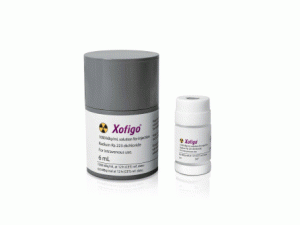镭Ra 223二氯静脉注射剂(Xofigo Inj kit 6ml)
 产地国家:瑞士
处方药:是
所属类别: 6000 kBq/0.6毫升/瓶
包装规格: 6000 kBq/0.6毫升/瓶
计价单位:套件
生产厂家英文名:Bayer (Schweiz) AG
原产地英文商品名:Xofigo 0.6ML/SYRINGE/KIT
原产地英文药品名:Radium Ra 223 dichloride
中文参考商品译名:Xofigo注射器 0.6毫升/套
中文参考药品译名:二氯化镭-233
产地国家:瑞士
处方药:是
所属类别: 6000 kBq/0.6毫升/瓶
包装规格: 6000 kBq/0.6毫升/瓶
计价单位:套件
生产厂家英文名:Bayer (Schweiz) AG
原产地英文商品名:Xofigo 0.6ML/SYRINGE/KIT
原产地英文药品名:Radium Ra 223 dichloride
中文参考商品译名:Xofigo注射器 0.6毫升/套
中文参考药品译名:二氯化镭-233
简介
部份中文镭Ra 223二氯处方资料(仅供参考) 英文药名:radium Ra 223 dichloride 商品名称:XOFIGO 中文药名:镭Ra 223二氯静脉注射剂 生产厂家:拜耳公司药品简介XOFIGO(镭Ra 223二氯[radium Ra 223 dichloride])注射液,用于静脉注射 首次批准:2013年 作用机制:Xofigo的活性部分是α粒子发射同位素镭-223(作为镭Ra 223二氯化物),其模拟钙并在骨转移增加的区域例如骨转移的区域形成与骨矿物质羟基磷灰石的复合物。 α发射体(80keV /微米)的高线性能量转移导致相邻细胞中双链DNA断裂的高频率,导致对骨转移的抗肿瘤作用。 镭-23二氯化物的α粒子范围小于100微米(小于10个细胞直径),这限制了对周围正常组织的损伤。 适用范围及用途:Xofigo是一种用于治疗阉割抗性前列腺癌,有症状骨转移和无已知内脏转移性疾病的患者的α粒子发射放射治疗剂。 剂量和管理:Xofigo的剂量方案为每kg体重55kBq(1.49微克),以4周为间隔进行6次注射。剂量形式和强度在参考日,浓度为1,100kBq/mL(30微克/mL)的一次性小瓶,在参考日期的总放射性为6,600kBq/小瓶(178微克/小瓶) 禁忌症:怀孕 警告和注意事项:骨髓抑制:在治疗开始前和每剂Xofigo之前测量血液计数。如果血液学值在治疗后6至8周内未恢复,则停用Xofigo。仔细监测骨髓储备受损患者。尽管有支持性的护理措施,但是在持续生活危险的并发症的患者中停用Xofigo。 不良反应:接受Xofigo的患者最常见的不良药物反应(≥10%)为恶心,腹泻,呕吐和外周水肿。最常见的血液学实验室异常(≥10%)是贫血,淋巴细胞减少,白细胞减少,血小板减少和中性粒细胞减少。 存储:将Xofigo存储在原始容器中或等效的辐射屏蔽。英文版说明书
Xofigo® (radium Ra 223 dichloride) injection is indicated for the treatment of patients with castration-resistant prostate cancer (CRPC), symptomatic bone metastases and no known visceral metastatic disease.Important Safety Information•Contraindications: Xofigo is contraindicated in women who are or may become pregnant. Xofigo can cause fetal harm when administered to a pregnant woman•Bone Marrow Suppression: In the randomized trial, 2% of patients in the Xofigo arm experienced bone marrow failure or ongoing pancytopenia, compared to no patients treated with placebo. There were two deaths due to bone marrow failure. For 7 of 13 patients treated with Xofigo bone marrow failure was ongoing at the time of death. Among the 13 patients who experienced bone marrow failure, 54% required blood transfusions. Four percent (4%) of patients in the Xofigo arm and 2% in the placebo arm permanently discontinued therapy due to bone marrow suppression. In the randomized trial, deaths related to vascular hemorrhage in association with myelosuppression were observed in 1% of Xofigo-treated patients compared to 0.3% of patients treated with placebo. The incidence of infection-related deaths (2%), serious infections (10%), and febrile neutropenia (<1%) was similar for patients treated with Xofigo and placebo. Myelosuppression —notably thrombocytopenia, neutropenia, pancytopenia, and leukopenia— has been reported in patients treated with Xofigo.Monitor patients with evidence of compromised bone marrow reserve closely and provide supportive care measures when clinically indicated. Discontinue Xofigo in patients who experience life-threatening complications despite supportive care for bone marrow failure•Hematological eva luation: Monitor blood counts at baseline and prior to every dose of Xofigo. Prior to first administering Xofigo, the absolute neutrophil count (ANC) should be ≥1.5 × 109/L, the platelet count ≥100 × 109/L, and hemoglobin ≥10 g/dL. Prior to subsequent administrations, the ANC should be ≥1 × 109/L and the platelet count ≥50 × 109/L. Discontinue Xofigo if hematologic values do not recover within 6 to 8 weeks after the last administration despite receiving supportive care•Concomitant Use With Chemotherapy: Safety and efficacy of concomitant chemotherapy with Xofigo have not been established. Outside of a clinical trial, concomitant use of Xofigo in patients on chemotherapy is not recommended due to the potential for additive myelosuppression. If chemotherapy, other systemic radioisotopes, or hemibody external radiotherapy are administered during the treatment period, Xofigo should be discontinued•Administration and Radiation Protection: Xofigo should be received, used, and administered only by authorized persons in designated clinical settings. The administration of Xofigo is associated with potential risks to other persons from radiation or contamination from spills of bodily fluids such as urine, feces, or vomit. Therefore, radiation protection precautions must be taken in accordance with national and local regulations•Fluid Status: Dehydration occurred in 3% of patients on Xofigo and 1% of patients on placebo. Xofigo increases adverse reactions such as diarrhea, nausea, and vomiting, which may result in dehydration. Monitor patients’ oral intake and fluid status carefully and promptly treat patients who display signs or symptoms of dehydration or hypovolemia•Injection Site Reactions: Erythema, pain, and edema at the injection were reported in 1% of patients on Xofigo•Secondary Malignant Neoplasms: Xofigo contributes to a patient’s overall long-term cumulative radiation exposure. Long-term cumulative radiation exposure may be associated with an increased risk of cancer and hereditary defects. Due to its mechanism of action and neoplastic changes, including osteosarcomas, in rats following administration of radium -223 dichloride, Xofigo may increase the risk of osteosarcoma or other secondary malignant neoplasms. However, the overall incidence of new malignancies in the randomized trial was lower on the Xofigo arm compared to placebo (<1% vs 2%; respectively), but the expected latency period for the development of secondary malignancies exceeds the duration of follow up for patients on the trial•Subsequent Treatment with Cytotoxic Chemotherapy: In the randomized clinical trial, 16% patients in the Xofigo group and 18% patients in the placebo group received cytotoxic chemotherapy after completion of study treatments. Adequate safety monitoring and laboratory testing was not performed to assess how patients treated with Xofigo will tolerate subsequent cytotoxic chemotherapy•Adverse Reactions: The most common adverse reactions (≥10%) in the Xofigo arm vs the placebo arm, respectively, were nausea (36% vs 35%), diarrhea (25% vs 15%), vomiting (19% vs 14%), and peripheral edema (13% vs 10%). Grade 3 and 4 adverse events were reported in 57% of Xofigo-treated patients and 63% of placebo-treated patients. The most common hematologic laboratory abnormalities in the Xofigo arm (≥10%) vs the placebo arm, respectively, were anemia (93% vs 88%), lymphocytopenia (72% vs 53%), leukopenia (35% vs 10%), thrombocytopenia (31% vs 22%), and neutropenia (18% vs 5%)。用药温馨提示:当您服用此药物时,需定期接受医疗专业人士的检查,以便随时针对其药效、副作用等情况进行监测。本网站所包含的信息旨在为患者提供帮助,不能代替医学建议和治疗。
药品价格查询,专业药品查询网站,药品说明书查询,药品比价 » 镭Ra 223二氯静脉注射剂(Xofigo Inj kit 6ml)
药品价格查询,专业药品查询网站,药品说明书查询,药品比价 » 镭Ra 223二氯静脉注射剂(Xofigo Inj kit 6ml)



